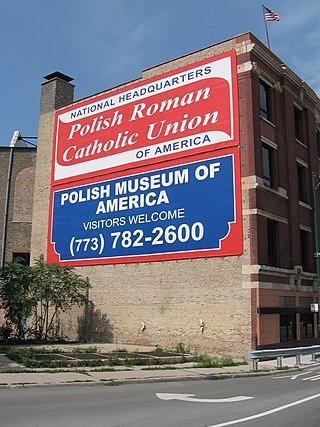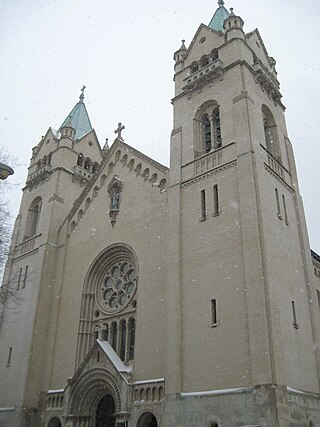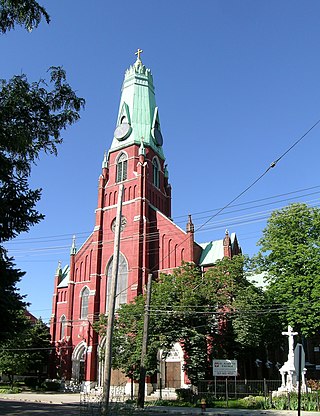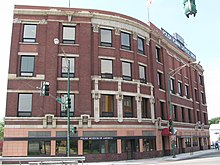
Polish Americans are Americans who either have total or partial Polish ancestry, or are citizens of the Republic of Poland. There are an estimated 8.81 million self-identified Polish Americans, representing about 2.67% of the U.S. population, according to the 2021 American Community Survey conducted by the U.S. Census Bureau. Polish Americans are the second-largest Central European ethnic group after German Americans, and the eighth largest ethnic group overall in the United States.

The Polish Roman Catholic Union of America ("PRCUA") is the oldest Polish American organization in the United States. Currently licensed to sell its products in 27 states, it is a fraternal benefit society providing financial security to its members through competitive life insurance and annuities, and offering opportunities for cultural, educational and spiritual growth.

The Basilica of Saint Hyacinth is a historic church of the Roman Catholic Archdiocese of Chicago, located at 3636 West Wolfram Street in the Avondale neighborhood of Chicago, Illinois.

West Town, northwest of the Loop on Chicago's West Side, is one of the city's officially designated community areas. Much of this area was historically part of Polish Downtown, along Western Avenue, which was then the city's western boundary. West Town was a collection of several distinct neighborhoods and the most populous community area until it was surpassed by Near West Side in the 1960s. The boundaries of the community area are the Chicago River to the east, the Union Pacific railroad tracks to the south, the former railroad tracks on Bloomingdale Avenue to the North, and an irregular western border to the west that includes the city park called Humboldt Park. Humboldt Park is also the name of the community area to West Town's west, Logan Square is to the north, Near North Side to the east, and Near West Side to the south. The collection of neighborhoods in West Town along with the neighborhoods of Bucktown and the eastern portion of Logan Square have been referred to by media as the Near Northwest Side.

St. Stanislaus Roman Catholic Oratory is a Roman Catholic parish in the historic Mitchell Street District of Milwaukee, Wisconsin. It was designed by Polish nobleman Leonard Kowalski, one of Milwaukee's early Polish residents, who took the name Leonard Schmidtner and spoke German.

Wicker Park is a neighborhood in the West Town community area of Chicago, Illinois, west of the Kennedy Expressway, east of Humboldt Park, and south of the Bloomingdale Trail, known for its hipster culture, art community, nightlife, and food scene.

Vincent Barzyński, C.R. (1838–1899) was a Polish-American Roman Catholic priest and organizer of the Polish-American community.

The Polish Cathedral architectural style is a North American genre of Catholic church architecture found throughout the Great Lakes and Middle Atlantic regions as well as in parts of New England. These monumentally grand churches are not necessarily cathedrals, defined as seats of bishops or of their dioceses.

Saint Mary of the Angels is a historic church of Roman Catholic Archdiocese of Chicago in Chicago, Illinois.

Saint Stanislaus Kostka Catholic Church is a historic Polish church of the Roman Catholic Archdiocese of Chicago that is located at 1351 West Evergreen Avenue in the Pulaski Park neighborhood of Chicago, Illinois, United States. It is designated as the Sanctuary of Divine Mercy of the Archdiocese.

St. Hedwig's Church is a historic parish church of the Roman Catholic Archdiocese of Chicago located in Chicago, Illinois. Constructed in the grand Polish Cathedral style, it is one of the many monumental Polish churches visible from the Kennedy Expressway. The church is located at 2226 North Hoyne Avenue.

Holy Innocents Church,, is a church of the Roman Catholic Archdiocese of Chicago located at 743 North Armour Street in the East Village neighborhood of Chicago, Illinois. It is a prime example of the so-called "Polish Cathedral style" of churches in both its opulence and grand scale.

Holy Trinity Church is a historic church of the Roman Catholic Archdiocese of Chicago located at 1118 North Noble Street. It is a prime example of the so-called 'Polish Cathedral style' of churches, in both its opulence and grand scale. Along with such monumental religious edifices as St. Mary of the Angels, St. Hedwig's or St. John Cantius, it is one of the many Polish churches that dominate over the Kennedy Expressway in the Pulaski Park neighborhood of Chicago, Illinois.

Saint John Cantius Church is a historic Catholic church of the Archdiocese of Chicago known for its architecture, liturgical practices, and affiliation with the Canons Regular of St. John Cantius.

St. Josaphat is a historic church of the Roman Catholic Archdiocese of Chicago located at 2311 North Southport Avenue in Chicago, Illinois.

Both immigrant Poles and Americans of Polish heritage live in Chicago, Illinois. They are a part of worldwide Polonia, the Polish term for the Polish Diaspora outside of Poland. Poles in Chicago have contributed to the economic, social and cultural well-being of Chicago from its very beginning. Poles have been a part of the history of Chicago since 1837, when Captain Joseph Napieralski, along with other veterans of the November Uprising first set foot there. As of the 2000 U.S. census, Poles in Chicago were the largest European American ethnic group in the city, making up 7.3% of the total population. However, according to the 2006–2008 American Community Survey, German Americans and Irish Americans each had slightly surpassed Polish Americans as the largest European American ethnic groups in Chicago. German Americans made up 7.3% of the population, and numbered at 199,789; Irish Americans also made up 7.3% of the population, and numbered at 199,294. Polish Americans now made up 6.7% of Chicago's population, and numbered at 182,064. Polish is the third most widely spoken language in Chicago behind English and Spanish.

Polonia Triangle, also known as the Polish Triangle, is located in West Town, in what had been the historical Polish Downtown area of Chicago. A single-tiered fountain made of black iron with a bowl about nine feet in diameter is installed at its center. Polonia Triangle derives its name from the Polish word Polonia, which means 'Polish diaspora'. Polonia Triangle was considered to be the center or town square of Chicago's Polish Downtown, the city's oldest and most prominent Polish settlement. In many ways it functioned as the capital of the American Polonia with the headquarters for almost every major Polish organization in the United States clustered within its vicinity.

St. Albertus Roman Catholic Church is in the Forest Park neighborhood of Detroit, Michigan. It was designated a Michigan State Historic Site in 1974 and listed on the National Register of Historic Places in 1978.
Antoni Klawiter, the Roman Catholic and, afterward, independent Polish Catholic priest, was born in Chojnice, in modern Poland, on November 12, 1836. The scholarly consensus is that he was the son of Polonized Germans; by virtue of his Kashubian birthplace and his later experience pastoring Kashubians in Winona, Minnesota, he will not have been unfamiliar with the Kashubian culture. In 1859, he was ordained a Roman Catholic priest in Włocławek, and became four years afterward one of many Polish priests who were involved with the Polish Insurrection of 1863. In late 1873 or early 1874, Father Klawiter emigrated to the United States.

Peter Kiołbassa was a Polonia activist and Democratic politician in the city of Chicago, serving as Chicago Treasurer and Commissioner of Public Works. Nicknamed "Honest Pete" because he refused to take city funds from financial decisions made as Treasurer, he broke from the tradition of his predecessors. He was the first Pole to be elected to such positions in the city. He was a major organizer of St. Stanislaus Kostka Church, and worked as president of the Polish Roman Catholic Union of America, in order to regain the Poles' loyalty to the Roman Catholic Church.



















